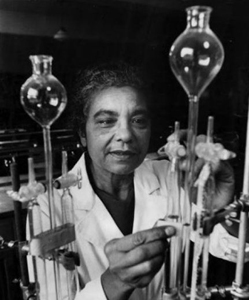Mary Elliott Hill facts for kids
Quick facts for kids
Mary Elliott Hill
|
|
|---|---|
 |
|
| Born | January 5, 1907 |
| Died | February 12, 1969 (aged 62) |
| Alma mater | |
| Known for |
|
| Spouse(s) | Carl McClellan Hill (1907–1995) m. ca 1925 |
| Scientific career | |
| Fields | |
| Institutions | |
Mary Elliott Hill (born January 5, 1907 – died February 12, 1969) was a pioneering African-American chemist. She was one of the first Black women to earn a master's degree in chemistry. Mary Hill was skilled in both organic and analytical chemistry.
She was famous for her work with ultraviolet light. She also helped create new ways to make plastics. She did this important work with her husband, Carl McClellan Hill. Mary Hill developed special methods to study chemical reactions. She used tools like spectrophotometers to track how reactions changed.
Contents
Early Life and School
Mary Elliott Hill was born in a small, segregated town called South Mills, North Carolina. This was on January 5, 1907. She grew up with two brothers. Her mother was Frances Bass, and her father, Robert Elliott, worked as a fireman.
In 1925, Mary started college at Virginia State College for Negroes. This school is now known as Virginia State University (VSU). She studied chemistry and earned her bachelor's degree in 1929.
Her Amazing Career
After finishing her degree, Mary Hill began teaching. In 1930, she taught at VSU's Laboratory High School. She also taught chemistry part-time at the Hampton Institute starting in 1932. By 1937, she became a full-time professor there.
From 1938 to 1942, she returned to teach at VSU. During the summers, she continued her studies at the University of Pennsylvania. In 1941, she made history. She became the first African-American woman to receive a master's degree in chemistry.
Teaching at Different Colleges
Mary Hill taught at Bennett College in North Carolina for a year. Then, in 1944, she became an assistant professor at Tennessee A & I State College. This school is a historically black college. She was a chemistry professor there until 1962. For part of that time, from 1951 to 1962, she was even the acting head of the chemistry department.
In 1962, her husband, Carl McClellan Hill, became president of Kentucky State College. Mary moved with him to Frankfort, Kentucky. She then became a chemistry professor at Kentucky State.
Working with Her Husband
Mary and Carl Hill often worked together as a team. Mary was an expert in analytical chemistry. This field focuses on understanding what chemicals are made of. The Hills used special chemical tools called Grignard reagents. They used these to create new ways to make ketenes. Ketene is a type of chemical compound.
Their research was supported by grants from the National Science Foundation (NSF) and the U.S. Air Force. Mary Hill developed the methods to analyze their work. She was especially good at working with simple ketenes. She used spectroscopic methods, like ultraviolet spectrophotometry. These methods helped her track how chemical reactions were progressing.
Her techniques were very important. They helped scientists figure out how much of different substances were in solutions. This allowed other chemists to find, separate, and measure new products. This work was useful for making plastics, which involves a process called polymerization of ketenes.
Helping Future Scientists
Mary Hill cared deeply about her students. She started student chapters of the American Chemical Society at some of the historically black colleges where she taught. It is thought that at least 20 of her students later became chemistry professors themselves. She also won awards for her excellent teaching.
She was a member of several important science groups. These included the Tennessee Academy of Science and the National Institute of Science. She was also part of honor societies like Alpha Kappa Alpha and Beta Kappa Chi.
Her Personal Life
Mary Hill was married to Carl McClellan Hill. The exact date of their wedding is not known, but it was likely between 1925 and 1927. They had three children together.
In a newspaper interview from 1963, Mary shared some of her hobbies. She enjoyed reading and studying German and Russian. She also liked arranging flowers and watching football. The Hills were active members of their Presbyterian churches in Nashville, Tennessee, and Frankfort, Kentucky.
Mary Hill passed away on February 12, 1969. She had just returned from a trip to England. She died in King's Daughters Hospital in Frankfort, Kentucky, due to a heart condition she had for some time.
See also
 In Spanish: Mary Elliott Hill para niños
In Spanish: Mary Elliott Hill para niños

